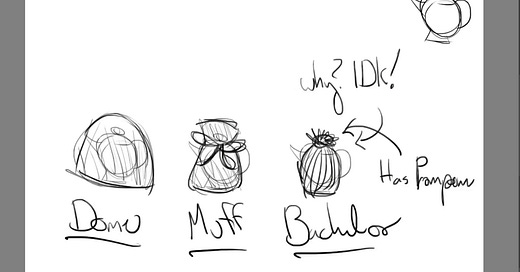This is a video of my drawing and schematic designs for tea cozies that I designed for Spin Off magazine’s 2024 winter issue. The theme was “Deep Roots, Natural Fibres.” “Our Winter issue gets to the heart of handspinning, exploring how natural fibers connect global communities.”
I was thinking about how people are connected around the world, and what we share. How does fibre connect us? Is it the production routes, the economies, the animals that produce them? All of those are plausible answers. Each one has its own merit.
Fibre connects us during production
Production routes encompass how fibres move from field to mill to loom to shop. Each farm chooses the mills that they send their fleece to. The yarn mills are supported by those farms, processing the fleece into top, roving, sliver, and yarn. This is then sold at the mill, sent to be woven, or sold wholesale at shops. Eventually the processed fibre arrives in shops as roving, top, sliver (s-lie-ver), yarn, or fabric. Where and when which fibre and what form it takes is dictated by the strength of each country’s economy.
Fibre connects us between countries
The strength of economies around the world dictates where fibres are sources and how they are priced across the planet. People want a good deal. The best bang for your buck involves quality and quantity. A country that has a low dollar exchange yet produces poor quality goods will not receive the patronage of stronger countries. At the same time, a country with a strong economy that produces high quality goods may have trouble sending their products abroad. This exchange of goods then has feedback through the supply chain to the farms, bolstering some fibres (or breeds) over others.

It’s a balance of give and take. The ebb and flow of goods across this complex system.
Animals connect us through their fibre
Is it the animals that connect us together? Most people have never seen a sheep in person. Nevermind an alpaca, goat, rabbit, or buffalo. How many people do you know who have cradled a precious silk cocoon in their palm? Have you ever done so? (I should find my silk cocoon to show you). Trends may encourage increases in the population of Merino or Blue Faced Leicester (BFL) sheep. Concerns about heritage breeds may support rare sheep or the cultivation of peace silks such as Muga and Eri. That’s an influence from the trade routes and economies. That’s not from the animals themselves.
The animals not only provide the wool, they provide the experience. More often now, farms invite visitors onto their lands to visit their sheep. It has become a marker of a high quality farm. “Visit our animals! See how we take good care of them! Smile and laugh and fall in love with their personalities!” Visitors are welcome during shearing days, as it helps dispel the negative impression of shearing spread by certain hypocritical animal rights groups (we can talk about shearing standards later, maybe as part of an interview). Shearing day visits often allow the visitors to walk away with part or an entire fleece fresh off of the sheep and “in the grease.”
Watch some happy lambs play. Who doesn’t love seeing happy animals?
Mutual experience is what connects us.
Individuals across the world can hold fibre from the same breed, the same sheep, the same section of the fleece. They can experience the same moment as another person, and gain a glimpse into another life. A whole new perspective can be understood through this insight. Does another find it coarse or soft? It is warm to them? Too cold? Too warm?
I could go on, but I won’t dawdle here. Fibre connects us because it is something that we experience every day, either through intentional study or just from getting dressed in the morning. We could all connect to each other just by talking about what our clothes are made of.
By discussing the fibres themselves we can connect more precisely to their place of origin. The animals that grow these fibres, the environment that encouraged their evolution, and the people who now reside in it.
I just accidentally wrote an essay. Welp.
How did this lead to submitting a pattern for tea cozies?
What is something that people do every day? Drink a hot beverage.
Tea is a hot (and cold) beverage that people all over the world drink. There are many different kinds of tea, ways to prepare, and ways to drink it. Some people really like tea (hello). They like tea enough to make whole teapots full of tea and drink it over a few quiet hours. If only the tea would stay hot all afternoon!
A teapot tea cozy will keep the tea warm :D






Share this post